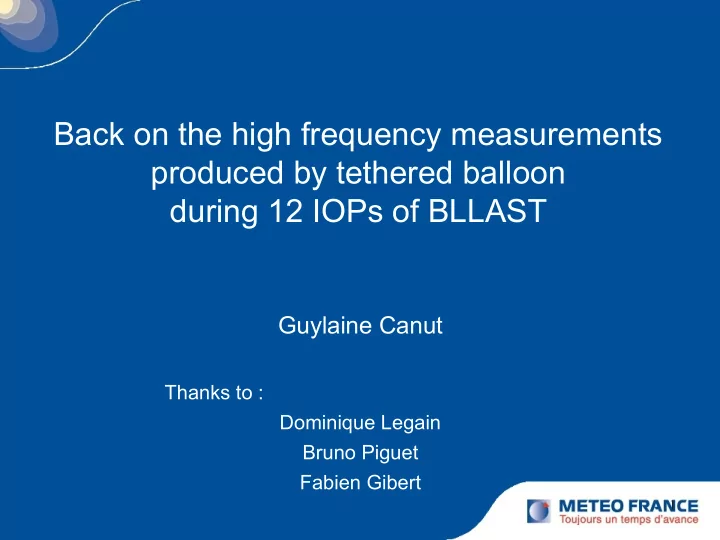

Back on the high frequency measurements produced by tethered balloon during 12 IOPs of BLLAST Cliquez pour modifier le style du titre Guylaine Canut Cliquez pour modifier le style des sous-titres du masque Thanks to : Dominique Legain Bruno Piguet Fabien Gibert 1
1. Approach and data 2. The turbulent parameters : Estimates the : Cliquez pour modifier le style du titre • Variance • Heat flux • TKE Cliquez pour modifier le style des • Dissipation rate sous-titres du masque 3. Balloon and windcube Lidar 4. Conclusion 2
1. Approach and data 15 flights - several plans, - about 8 hours per day, - u v w t measurements at 10 Hz - estimation of the sensible heat flux every 20 minutes - variance every 5 minutes Sonic anemometer & Xsens (inertial motion+GPS) 3
1. Approach and data Fluctuations of w & t Fluctuations of u & v Ongoing research to understand these peaks 4
2. The turbulent parameters Estimation of the variance of t, u , v, w (every 20 minutes) 5
2. The turbulent parameters Estimation of the heat flux (every 20 minutes) Example of 2 different days 6
2. The turbulent parameters Estimation of the TKE - 15 days - every 20 minutes 7
2. The turbulent parameters Estimation of the dissipation rate 0,8< f <2Hz 8
3. Balloon and windcube Lidar m/s - vertical velocity measurements with Lidar & sonic anemometer - windcube (0,25Hz) - unfortunately, only 4 days with both data 9
3. Balloon and windcube Lidar - variance of vertical velocity (every 5 minutes at the similar altitude) For this 4 days, the variance from the Lidar is available at all the levels 10
3. Balloon and windcube Lidar -Power spectral density of w 11
3. Balloon and windcube Lidar Comparison between the estimation of the Dissipation rate obtained by Lidar and sonic anemometer. 0,01< f <0,1Hz 12
Conclusion & perspectives - Data available, however it is necessary to be careful when using u and v... but we are confident that the problem is resolved quickly... - The w from the windcube lidar at 0.25 Hz gives a good description on the vertical structure, but not below 200m. - We plan to continue the investigation with variance measurements with Lidar (new small field campaign with a smaller temporal resolution and with the 3 wind components) - We will start a work with the scintillometer dataset (master student) 13
Recommend
More recommend